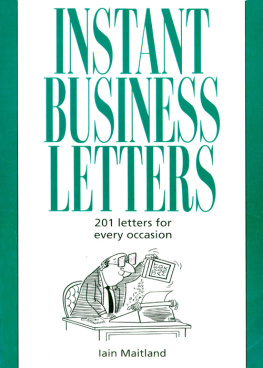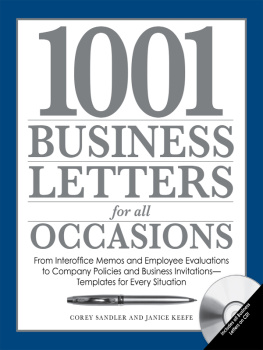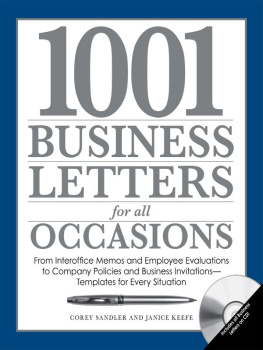THE
BUSINESS
LETTER
HANDBOOK
How to Write Effective
Letters & Memos for Every
Business Situation
Michael Muckian
& John Woods

ADAMS MEDIA CORPORATION
AVON, MASSACHUSETTS
Copyright 1996, John Woods. All rights reserved.
This book, or parts thereof, may not be reproduced in any form without permission from the publisher; exceptions are made for brief excerpts used in published reviews.
Published by Adams Media, a division of F+W Media, Inc.
57 Littlefield Street, Avon, MA 02322. U.S.A.
www.adamsmedia.com
ISBN 10: 1-55850-614-4
ISBN 13: 978-1-55850-614-5
Printed in the United States of America.
20 19 18 17 16 15 14 13 12 11
Library of Congress Cataloging-in-Publication Data
Muckian, Michael.
The business letter handbook : how to write effective letters & memos for every business situation / Michael Muckian & John Woods.
p. cm.
ISBN 1-55850-614-4 (pb)
1. Commercial correspondenceHandbooks, manuals, etc. I. Woods, John A. II. Title.
HF5726.M87 1996
808'.066651dc20 96-13660
CIP
This publication is designed to provide accurate and authoritative information with regard to the subject matter covered. It is sold with the understanding that the publisher is not engaged in rendering legal, accounting, or other professional advice. If legal advice or other expert assistance is required, the services of a competent professional person should be sought.
From a Declaration of Principles jointly adopted by a Committee of the American Bar Association and a Committee of Publishers and Associations
This book is available at quantity discounts for bulk purchases.
For information, call 1-800-289-0963.
Contents
Acknowledgments
We'd like to acknowledge Dick Staron, our editor at Adams Media Corporation, for suggesting this book and for his support throughout its development.
Preface
This book has two purposes: (1) to introduce you to some basic ideas about successful written communication via letters and memos and (2) to give you about three hundred sample letters dealing with fifty-four different business situations that you can adapt for your own use.
Clear and effective writing reflects clear and effective thinking. Such writing facilitates business action. It eliminates confusion. It helps people understand the whats, whys, and hows of business policies and decisions. It cements relationships or diplomatically ends them. Poorly written letters and memos, conversely, make matters worse and reflect negatively on the writer.
Nearly all business action involves communication. Many of the problems that occur in any business can be traced to misunderstandings and unclear communication between people. Effectively written letters and memos help minimize such misunderstandings. By following the suggestions in the introduction to this book and using the sample letters as guidelines, you can more easily prepare written communications that will say what you want them to in a straightforward, friendly, businesslike manner.
To use this book in any communication situation in which you find yourself, simply check the letters in each category to find the one that best fits your needs and make changes as appropriate. It is possible and even probable that you will encounter various business problems that are not included in the list of situations the sample letters cover. That does not preclude using the samples anyway. Simply choose a situation similar to one in which you have an interest and adapt the letter to your purpose.
Many companies, regardless of size, have installed electronic mail systems to facilitate internal communication. Recognizing the growing popularity of this medium, we have also included a short section on the use of e-mail and a variety of sample messages showing the uses of e-mail and the composition of e-mail messages.
Finally, here are a few important notes on using the sample letters:
All names, places, and situations in the sample letters are fictionaland any resemblance to real people, organizations, or events is coincidental.
The sample letters offer good models to be followedbut in order to create your own clear and effective communications, they must be thoroughly adapted and changed to fit your situation.
In cases where your communications involve legal issues or other professional or expert advice, be sure to also consult with a lawyer or other professional.
Introduction
You and Successful Written Communication
Countless hours have been spent defining what good communication is and, more importantly, how to do it. Theorists and social scientists draft diagrams of communications processes and develop complex social archetypes, all for the purpose of better understanding how people conceive and share ideas.
For our sake, however, let's dispense with ornate social theories. Plainly put, we either send or receive information via a common, mutually understood method. We then act on that information in some way.
Simpler still? You talk, write, or sign in a way you expect me to understand. I respond accordingly, using the same or a similar medium to signal my understanding, agreement, opposition, or any of dozens of other socially acceptable (or unacceptable) responses.
And no matter what the level of sophistication, all communications have one thing in common: They involve someone transmitting information and someone receiving. Eliminate either party and communication ceases to exist.
LETTERS AND COMMUNICATION
Business letters are no different. They're designed to inform, persuade, coerce, threaten, or just tell the recipient that his or her bill is past due. But if they're not written in a way that is easily understood and designed to effectively accomplish their goal, then they have not communicated and the task they are supposed to accomplish often goes undone.
Communication may be a two-way street, but the letter is a one-way medium. Unlike in conversation, there is no opportunity to seek clarification or refute major points during the course of the letter. To do so requires a return letter, which means more time, effort, and expense.
Any failure to communicate rests on you, the letter writer. True, some gaps simply cannot be bridged. But most can, and a good letter writer takes the responsibility for making the best effort possible to create such bridges, thus shortening the communication process and increasing the productivity in accomplishing the tasks the letter was sent out to promote.
Clarity and brevity in communication, especially in today's stimulus-choked society, is just common sense. But it is also part of an effort to enhance quality in the broader sense. No matter what your business philosophy, you know that professionalism leads to higher-quality operations and more effective results. And the more quality you can bring to your letters in terms of clarity, content, style, expediency, and completeness, the more time you save the recipient. Not only will that person appreciate understanding even bad news with a minimum amount of rhetorical gobbledygook, but you will accomplish your goal that much more quickly.
And from anyone's standpoint, that's good business.
THE ELEMENTS OF GOOD WRITING
Legend has it that Ernest Hemingway was a first-rate letter writer, turning to correspondence when his literary muse was trussed up in a corner, unable to inspire or perhaps not yet sober from the previous evening's revelry. He would write to friends, family, editors, and sometimes total strangers, sharing ideas, advice, insight, and information with much the same stylistic acuteness that earned him critical acclaim for novels like
Next page








